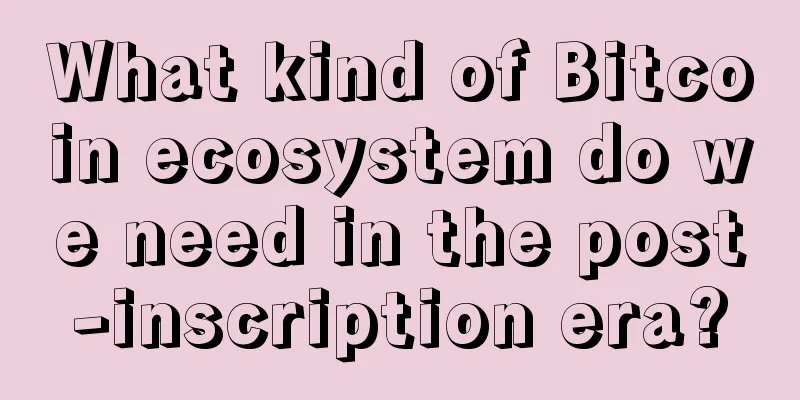Why hasn't Bitcoin achieved widespread adoption yet?

|
Abstract: Foreign media TechCrunch wrote an article pointing out why Bitcoin and other cryptocurrencies have not yet achieved widespread popularity? What obstacles have hindered their development? The article said that large price fluctuations and lack of stability are a major obstacle to their development. The following is the main content of the article: Speculators have flocked to Bitcoin and many other cryptocurrencies in the hope of getting in early and making a fortune, but ordinary users have not had much enthusiasm for cryptocurrencies. There are many reasons for this, but one of the biggest obstacles to the widespread popularity of these currencies is their huge price volatility. The question is why are the prices of cryptocurrencies so volatile? It all comes down to supply and demand: most cryptocurrencies have a fixed supply, while their demand is uncertain and constantly fluctuates due to market speculation. Of course, discussing this problem isn’t difficult—what’s difficult is coming up with a solution. Why is price stability so important? In fact, it’s not just cryptocurrencies that need to be stable in price. Any currency needs to be stable so that they can be used as a trusted medium of exchange. The more volatile a currency is, the less likely ordinary people will use it in daily transactions. People are not used to thinking of cryptocurrencies as real money, and they either hoard them in the hope that they will increase in value in the near future, or avoid using them altogether for fear that they will become completely worthless. Worse, the unpredictable nature of cryptocurrency prices has had a severe impact on common financial services, such as remittances, currency exchanges and ATM usage. To use cryptocurrencies, companies must hedge their risks by charging outrageous fees. Bitcoin ATMs charge up to 15% for fiat currency conversions. This completely defeats the purpose of cryptocurrencies in the first place: to provide a cheaper, more flexible alternative to other payment methods. Cryptocurrencies offer no advantages over government-printed money, so why would ordinary people want to use them? Patience is needed Price volatility has plagued Bitcoin since its inception. From what we have observed over the past decade, why has cryptocurrency not yet solved this price volatility problem? As always, human nature gets in the way. Stabilizing the price of cryptocurrencies is not easy in an environment where people prefer to speculate and resell their coins at the highest possible price to get instant gratification. Cryptocurrencies were not carefully planned at the beginning, so it is very difficult to overcome the influence of market speculation. Phase 1: Building a stable ecosystem When creating a cryptocurrency from scratch, you first need a stable foundation. With this foundation, the currency can continue to improve itself as it develops. Estimating needs The first step to this is to be able to effectively estimate market demand. Uncertainty in demand is a major cause of price volatility, as the intentions of each user are a mystery to any other user. Having a way to estimate the actual market demand for a currency would go a long way toward solving this problem. However, the problem with market demand estimates is that speculators create artificial demand. This is the core of the problem: due to widespread speculation, the price of cryptocurrency does not reflect its actual usage and demand. It has become a bubble that is always on the verge of bursting, and no one wants to take the risk of losing their hard-earned money. Traditionally, the solution to the problem of price stability has been to establish a central bank. This allows the government to adjust the money supply at will, for example by causing inflation. Cryptocurrencies are decentralized by definition - one of their strengths - and without a central bank, they require a completely new solution to curbing price volatility. They need to curb volatility without sacrificing user freedom and without causing inflation. Encouraging cooperation rather than competition: decentralized communities "United we stand, divided we fall." What if cryptocurrencies encouraged people to collaborate? What if people were motivated by a spirit of growth, rather than greed? In this ideal model, a network of cooperating businesses and services would coordinate as a single entity. The currency would be democratically shaped (shaped, not controlled) by this collaboration. Every user would have an incentive to help the network grow, and the use of blockchain would make the process fair and equitable. Instead of rampant online speculation, users would go to local exchanges to buy and sell coins. The entire community would vote on when to increase the price of the coin, a model that would keep things democratic while preventing the currency from skyrocketing. Local official exchange The ability to physically see other users and look them in the eye during a transaction is a huge difference from trading directly online. Face-to-face trading in a trusted location means that buying and selling of a currency can be more easily limited, which can help gauge market demand. People who are on the "front line" and witnessing the real demand for the currency can then vote on whether to increase the price of the currency. Having a fixed place to trade currency also brings consistency. This can eliminate the confusion of where people can buy and sell currencies. These benefits aren’t just limited to economics, either. Cryptocurrencies tend to attract unscrupulous and unscrupulous people, so they don’t necessarily have the best reputation. However, a cooperative network based on face-to-face transactions can go a long way toward legitimizing the currency by voting out unethical or illegal businesses. Of course, such businesses may still exist, but they will never be part of the cooperative network. Dominated by local exchanges This model can only work if there are far more local exchanges than online exchanges. That would mean that local exchanges have pricing power over the currency. In the past, promotion would lead to disaster. Hype is a powerful force, so it needs to be handled carefully. On the one hand, it’s natural for founders to want to attract outside investment early on. This will drive up the price of the currency, help pay for infrastructure, and promote the currency’s development. On the other hand, historically, the earliest investors in cryptocurrencies tend to be of low quality—they are speculators who are pessimistic about the long-term development of cryptocurrencies and scare off mainstream users. Due to the existence of speculation, cryptocurrencies need capital injection to maintain price stability, which is a very important task. Take Bitcoin as an example: its total market value is about 20 billion US dollars, and it requires huge funds to maintain price stability. Steady and steady is the right way Cryptocurrencies are still in their early stages of development, and it's unclear where most of the major cryptocurrencies are headed. What "finish line" are they aiming for? How will they end up? Most cryptocurrencies have no direction to go, except for the whims of the market, so it's hard to say what they will eventually become. However, there are some interesting coins that have developed development strategies and are therefore heading in a specific direction. Center Application Currency Model The strategy is centered around creating value with unique products and services tied to the currency. In this way, you can say the currency is backed by something that people actually want. For example, the MaidSafe network encourages users to provide valuable things to its network (storage space), provide applications and services in exchange for currency. This naturally promotes people's cooperation. People want to create value and want to contribute to the development of the currency they jointly own. Setting and switching modes Similar to the hub application strategy, this approach allows you to build a user base first and then introduce a currency. Bitshares and a host of related startups are a good example. Several networks with different currencies - such as Steemit and its STEEM currency, Peerplays and its currency - have slowly built their own user bases and value exchange systems, and now they plan to adopt a hub currency with Bitshares. This allows them to build a stable user base before gathering resources. Grassroots Movement Ultimately, the best way for cryptocurrencies to create that all-important real user base is through autonomous growth. Just like a commercial startup, a currency like this will need a user base that believes in the common mission. It requires everyone in the system to see the intrinsic value of the currency, to understand that it could be worth much more than it is in its early stages of development. One example of such a grassroots project is FairCoin. The currency was created and led by FairCoop, whose strategy is to create an ecosystem where companies collaborate to bring the most value to users. From the outset, the currency was created to encourage users to obtain long-term benefits rather than satisfy short-term greed - not only because it is the right thing to do, but also because it makes sense. FairCoin has been focused on building infrastructure for everyday users since the beginning. Because the cooperative members have strong relationships with each other, they have access to a large number of ATMs, debit cards, and exchanges, making it much easier to widely adopt the currency. A model like this allows the currency to grow slowly and quietly, without attracting the attention of the outside world and the speculators that come with the spotlight. This brings a huge advantage of stability from the beginning, although it also allows FairCoin to maintain its development with less funds than most cryptocurrencies. Unlike other cryptocurrencies, it cannot rely on CoinMarketCap to sing praises by showing artificially inflated prices (the influence of speculation). In other words, FairCoin trades the excitement and greed of price volatility for long-term stability that is invisible. The only problem is that people might not notice it! After all, drama is what attracts people’s attention. Hard Fork Issues Let's look at the hard fork problem facing Bitcoin. Now the currency may have two competing chains, which is a blessing in disguise. This is another technical hurdle to Bitcoin's mainstream adoption, which already has many technical hurdles. This will make the price of the currency even more uncertain, and uncertainty is poison to a currency. On the other hand, if there is a large community and cooperative on an immutable blockchain, a hard fork is unlikely to happen — nor is it necessary. Cryptocurrencies like MaidSafe, Bitshares, and FairCoin all have strong communities that encourage cooperation rather than opportunism. This means that the value of these coins can be higher than their market price; they have high intrinsic value within their own systems. This gives users little reason to defect from the existing community. Hard forks would mean giving up many of the benefits of the cooperative, so people stay loyal to the original vision of those currencies. When communities are connected by something deeper than greed, hard forks will occur less often. Summarize Price stability doesn’t happen by accident. It’s not a miracle of the market — it requires a carefully built foundation. A stable currency first requires a stable ecosystem. It is tempting to promote a currency too early and widely, as the infusion of funds can drive the price of a currency up during those critical development periods, but it is better to be patient and wait. Promotion is like opening Pandora's box, attracting attention. Some of those users will be interested in the actual currency, but others will be speculators who will piggyback on and exploit the system. For a currency to be stable, it needs to be used by the 99% of ordinary users, not just by a small number of investors. Money needs to grow with people, not outpace them. Look at what's happening with Bitcoin and its skyrocketing price. Regular people can no longer mine it, nor enjoy low fees when using it in daily transactions without taking the risk. The currency has become completely controlled by speculators. On the other hand, if the currency is truly stable, you can get financial services such as currency exchange, remittances, ATM withdrawals, etc. at a lower rate than the legal currency system. In other words, its use can meet people's expectations-acting as a currency. This can attract the mainstream public and really motivate them to turn to cryptocurrency. |
Recommend
Women with the most unhappy marriages
The happiness or unhappiness of marriage often de...
What are the pitfalls in the mining industry? —— Tempting futures
Introduction to the "Mining Pit Prevention G...
How is the fortune of a person with the Fire element of the Mountain?
In fact, not everyone has Fuzi eyes, but once you...
Facial features of people who are very pessimistic in life
An optimistic person is one who can maintain a po...
Complete diagram of the fate of the legal line
Both men and women have nasolabial folds, but no ...
Are women with flat noses blessed? What does a woman's flat nose mean?
Marriage fortune of a woman with a flat nose If a...
The face of a lonely old man
The face of a lonely old man 1. Mouth The commonl...
What kind of face is good? The face of an upright person
On the road of life, we meet a lot of people, som...
It's not easy to go overseas, and there's no way to stay behind: Chinese crypto miners are in a dilemma
At noon on June 19, a miner lamented on Weibo: &q...
FTX CEO: We are considering intervening to prevent the crisis from spreading
Cryptocurrencies are experiencing a spectacular c...
How to read the love line in palmistry
The love line is one of the main lines in our pal...
Women with narrow foreheads have bad career prospects
The forehead actually has a certain relationship ...
What are the seven facial features of a wealthy nose?
In Chinese physiognomy, the nose represents a per...
A Brief Discussion on the Good and Bad Omens of Moles
A Brief Discussion on the Good and Bad Omens of M...
Electric Power Resources Investment Promotion Conference and Bitcoin Miners Exchange Meeting-July 9 [Chengdu]
Bitcoin mining machines are inseparable from low-...









